It’s the PRIVATE Economy That Matters
There was a saying that became popular among politicians and others during the Clinton presidency, reminding people to focus on the economy as the important task. We’ll spare you that saying, and the negative epithet it contains, since you probably remember it.
That saying almost had it right. The economy does matter, even if all you are trying to do is get reelected. But what they did not realize then, and what many do not realize now, is that it is the private economy which really matters.
If you remember your macroeconomics class, you recall that GDP is the sum of several data points in this formula:
GDP = C + I + G + (X-M)
In English, that’s Consumption plus Investment plus Government spending, plus eXports minus iMports. The Bureau of Economic Analysis reports data on each of those components as well as on overall GDP. We had never seen a good analysis done about private GDP, so we decided to do one ourselves.
Here is a chart compares the total nominal GDP to private GDP, taking out government expenditures. The gap between the two lines represents the size of government spending at all levels, federal, state, and local. It is easy to see that this gap is getting bigger.
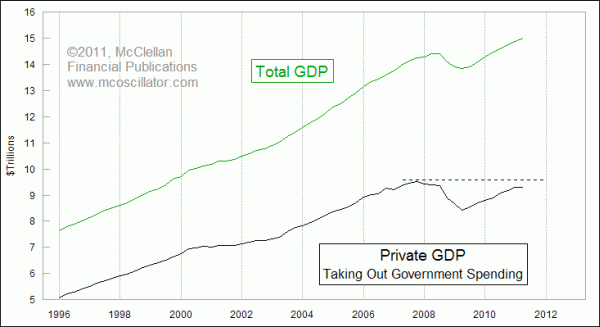
It is also easy to see that total nominal (not inflation adjusted) GDP is already above its 2008 peak, but private GDP has still not made it back. It is not a surprise that government spending in recent quarters has made up a larger share of total GDP, thanks to the various stimulus programs designed to “help” as well as the higher defense spending since 2001.
So to get an idea of just how high government spending has grown as a percentage of total GDP, we created this next chart. It shows how much of total GDP is accounted for by government spending. It may be a surprise to you to see that it has gotten up to the same levels seen at the height of WWII. It was to us.
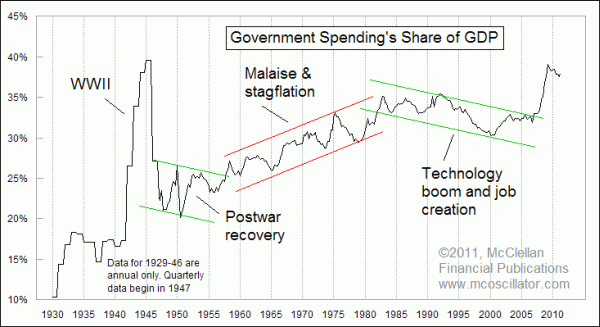
One point to understand is that government spending today is not exactly like it was when Simon Kuznets first developed the formula back in 1934. Back then, if the government spent money on something like a building or a battleship, that was a form of consumption. Somebody made it, and Uncle Sam bought it.
Now, with retiree payments and Social Security, the economists properly have to factor out spending on “transfer payments” like social security, pensions, welfare, and veterans’ benefits. Those payments don’t really involve “production” until the recipient spends them as “consumption”, so they get excluded.
What is interesting to us is that the periods when the government’s share of GDP is shrinking tend to be the better times for the economy. Some might say that, well sure, if there is a strong economy, the private sector will grow faster than the government. We believe that there is something deeper going on.
Rising government spending displaces private activity. If someone gets hired to work for the government, that means he is giving up the possibility of working in the productive sector, AKA the private sector. If a farmer grows a bushel of wheat, the wealth of the whole country will be increased by the value of that wheat. If a factory worker makes a box full of widgets, the country as a whole has its wealth increased by that many widgets.
But if a government regulator writes a new regulation, that effort does not really contribute to the wealth of the country. It might help protect the wealth of the country, by keeping some evildoer from taking someone else’s stuff, or polluting air or water. But it does not add to the “product” of the country.
This is the key point which the Keynesians miss. They argue for increased government spending during slow economic times to take up the slack, and stimulate more demand. But where is the evidence that it actually works? One cannot prove it based on the results of the grand Keynesian experiment of the 1930s. FDR’s Treasury Secretary Henry Morgenthau was quoted in Burton Fulsom’s 2008 book, New Deal or Raw Deal:
“We have tried spending money. We are spending more than we have ever spent before and it does not work. I have just one interest, and if I am wrong... somebody else can have my job. I want to see this country prosperous. I want to see people get a job. I want to see people get enough to eat. We have never made good on our promises ... I say after eight years of this Administration we have just as much unemployment as when we started... And an enormous debt to boot!”
And one cannot prove that Keynesian stimulus has worked in the current experiment that was begun in late 2007, when President Bush first proposed tax rebates and other programs that President Obama has amplified.
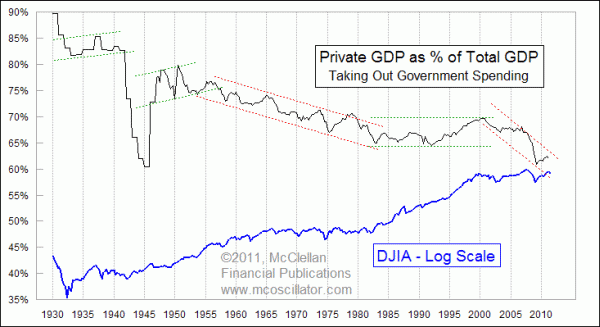
When we take the government’s share of GDP and turn it upside down, we get the private GDP as a percentage of the total, which is shown in the chart above. Not surprisingly, there is a great correlation between this data and the stock market. If you grow government, and crowd out private production, it tends to be bad for the stock market. But in instances when the government takes up a decreasing share and the private GDP is growing its share, such as the period just after WWII, and during the 1980s and 1990s, that leads to more production, more earnings, more liquidity, and a higher stock market.
This next chart zooms in closer on that same relationship between the DJIA and private GDP’s share of the total, looking at just the past 3 decades. It is pretty obvious that there is a relationship between the two.
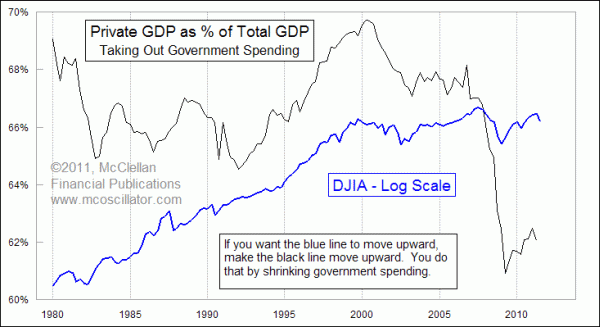
That is a really important point to know, especially when one is confronted with the assertion offered by some people who say that the only problem with the Obama administration's stimulus package was that it was not big enough. Had it indeed been bigger, then private GDP would have been even smaller as a percentage of the total, which would have been bad for the stock market and thus bad for the economy. It does not get the car moving by pushing on the brake harder. Push the lever the other way.
The way to get actual GDP up is not to have government spend more, but instead to have it spend less, freeing up people whose labors would be taken up by that government spending, so they can go out and “produce”.
It should also be understood that getting taxes up higher to pay for all of the ambitious government spending also works contrary to a growing economy. The final chart shows that federal tax (and other) receipts as a percentage of private GDP are inversely correlated with GDP growth. Saying it more simply, higher tax collections kill the economy. Getting it up really high, like what happened in 1980, 2000, and 2007, tends to lead to economic recessions.
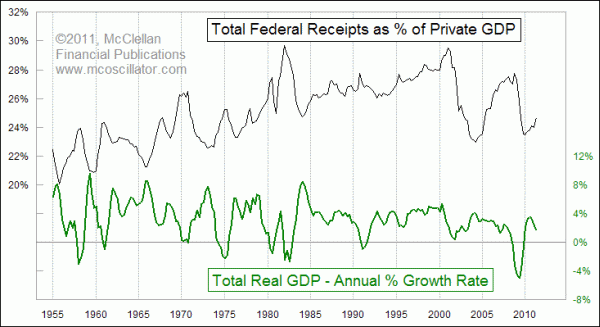
We should not have to re-learn in real time the lesson that our grandparents learned in the 1930s, after Herbert Hoover raised the top tax bracket from 25% to 63%, and it just made things worse. Thankfully, Congress seems to have turned a deaf ear to President Obama’s new “jobs” program, and the tax hikes it contains.
In 1993, President Clinton declared that it was “the worst economy in 50 years,” and that the only solution was to pass his $20 billion package of pork spending and political paybacks. Congress wisely refused then, and the economy did great. Congress was not as wise in 2008, and so the economy continues to stagnate. Shrink governments, and we’ll solve a lot of the economy's problems.